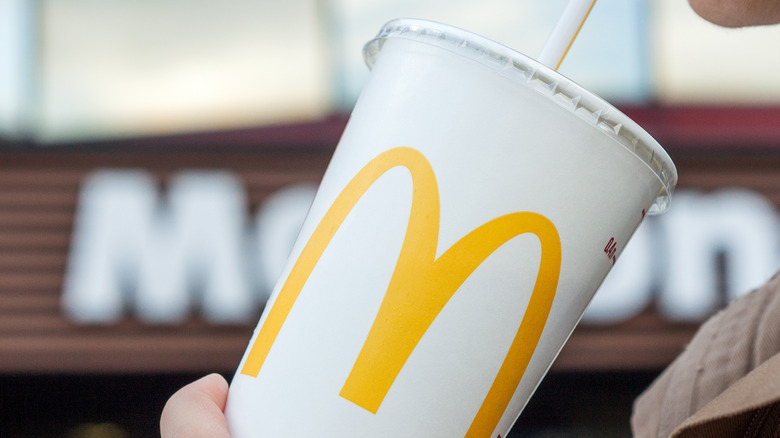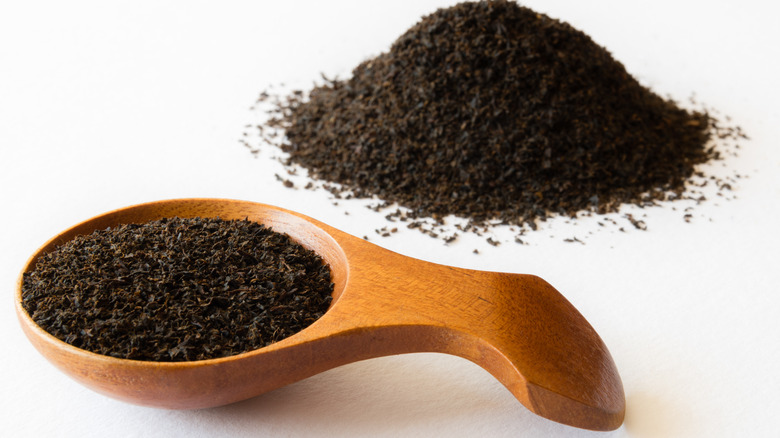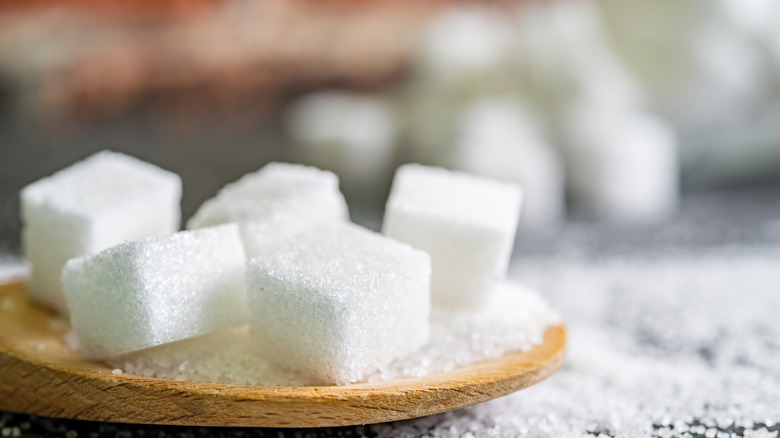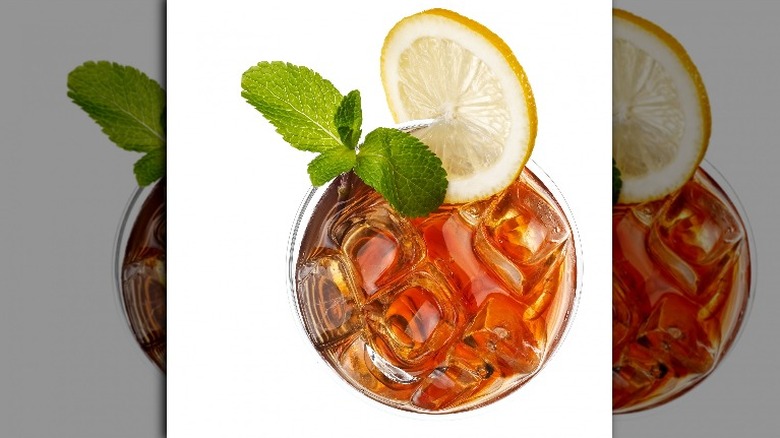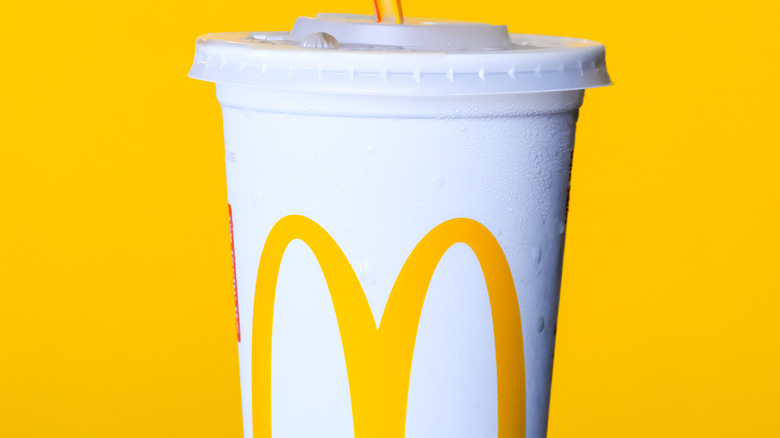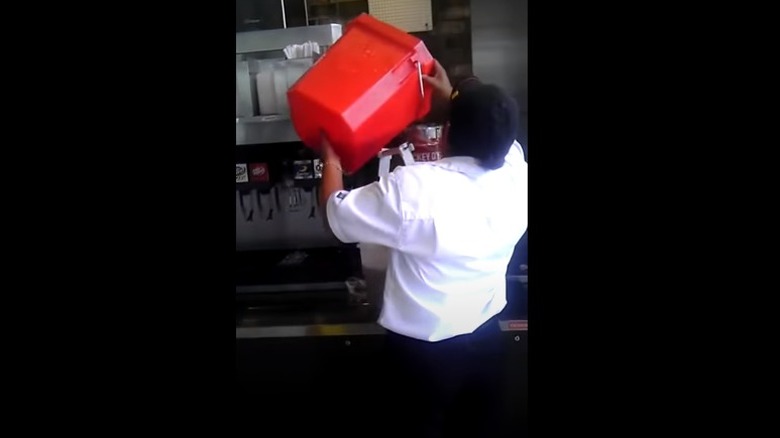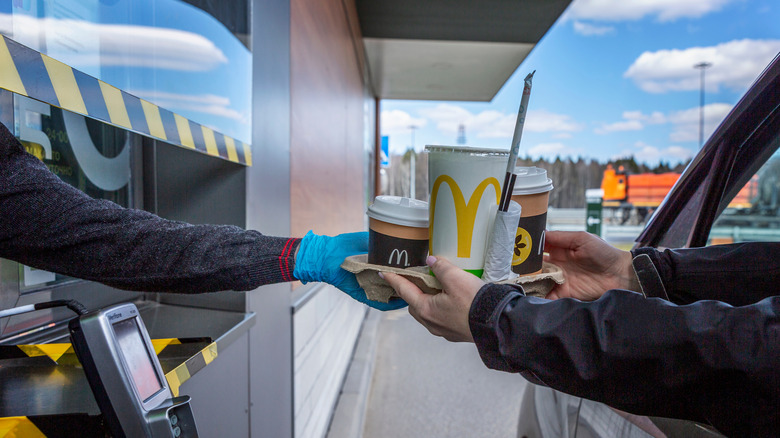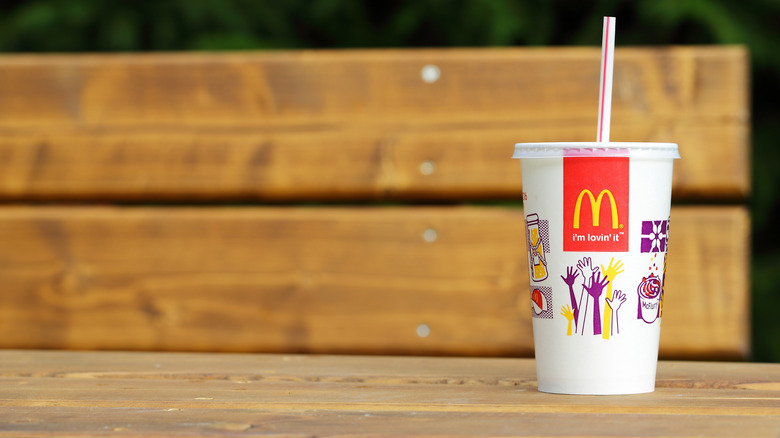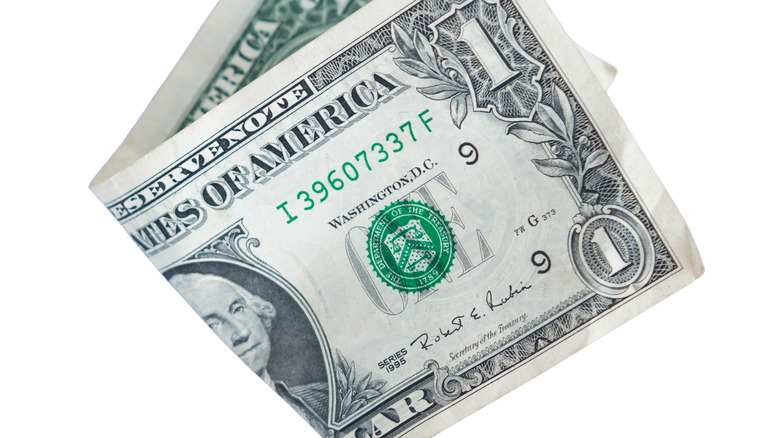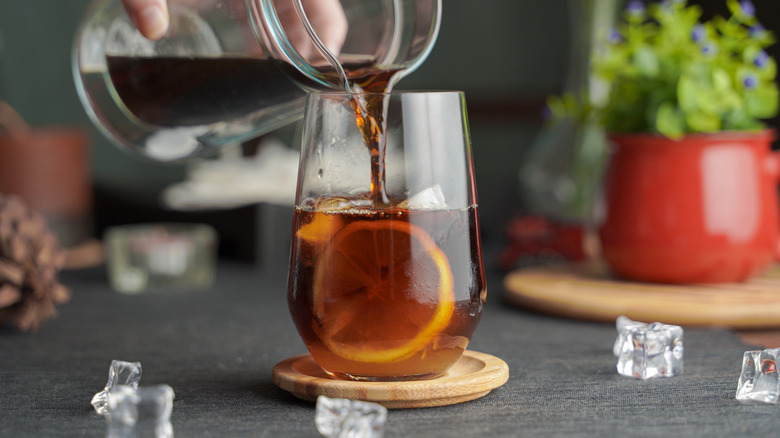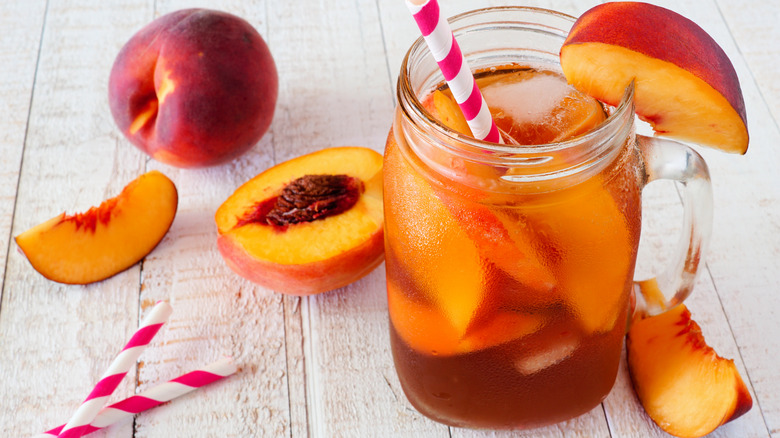The Truth About McDonald's Sweet Tea
All the refuge that you need from the scorching sun is in a cup of McDonald's sweet tea — be it the finger-numbingly cold plastic cup that it's served in, the rush from the heavily-sugared brew, or the refreshing mix of lemon and tea. There is something so satisfying about washing down a Big Mac with it, letting that sweetness linger long after a swig. It's a feeling that only Southerners would have been able to relate to if not for McDonald's intervention in 2008 (via Serious Eats).
Sweet tea was largely only popular in the Southeastern United States until the chain made it part of its nationwide menu. And for this reason, Mickey D's sweet tea is more than just a pleasant summer drink. It deserves the credit for pioneering a movement that blurred the boundary between the states that served sweet tea and those that didn't. McDonald's decision to offer the drink across all its 14,000 plus locations in the U.S. altered how the drink was perceived, consumed, and appreciated.
Unlike coffee or Coke which were part of McDonald's menu ever since its founding in 1940 (via The Sun), sweet iced tea is a more recent addition. But ever since it started out as a $1 drink during the Great Recession, it has gone through little change, except for the addition of a few cents to its price. Read up all about the beverage before your next McDonald's jaunt.
McDonald's sweet tea is made with orange pekoe
McDonald's sweet tea, according to the chain's website, is made with orange pekoe. Unless you are a tea sommelier, it is totally plausible that you ordered the beverage expecting something that tasted like Orangina. But then you took one swig to realize it's just plain tea with sugar and ice. So what's the deal with "orange pekoe" then? All it refers to is a grade of black tea sourced from India and Sri Lanka. Tea is graded depending on whether it includes broken leaves, buds, or the "finest" tips of the tea plant, according to Artful Tea. Each grade looks and tastes different. Broken leaves make for a stronger tea, tea buds give the tea a golden hue, and so on.
Orange pekoe is the basic one, consisting of whole tea leaves. Pekoe is Chinese for the downy hair found on the sides of young tea leaves. As explained in Boston Tea Party Ships and Museum website, Dutch traders bought this tea from Chinese merchants and gifted it to the House of Orange — the royal family of the Netherlands, calling it orange pekoe. Little did they know that the name would stick, and become a menu constant in one of the biggest fast food chains in the world.
McDonald's sweet tea has a crazy amount of sugar
No matter how many ice cubes you add, McDonald's sweet tea can be shockingly sweet. Even if your taste buds don't complain, your arteries might have a different story to tell. Analyzing the nutritional data of a sweet summer drink can be a buzz killer, but if you are a McDonald's regular, it would be wise to acknowledge that when you knock back a large sweet tea, your sugar quota is done for the day.
Here's why: a large sweet tea has 38g of sugar in it, according to McDonald's official website. That's more than the daily intake recommended by the American Heart Association, which states that men can have up to 37.5 grams, and women, up to 25 grams of sugar per day. Anything above that increases your chances of attracting a grim set of diseases such as obesity, type 2 diabetes, and general heart issues (via Healthline).
McDonald's uses a different type of sugar, though. "Medium invert sugar," as it's called, is slightly sweeter and doesn't crystallize like the normal sugar (via Prospector). However, Healthline notes that nutritionally speaking, they are all the same — sweet and dangerous.
Sweet tea is low in calories compared to other McDonald's beverages
First of all, if you are on a diet and still find yourself at a McDonald's drive-thru, you know that the chicken McNuggets beat your resolve. But if you are still mindful of the calories, order a sweet tea instead of a Coke to wash it down. One small sweet tea has 90 calories, which is much less than a Coke or Minute Maid Orange juice that packs 150 calories each (via McDonald's). Of course, the ideal choice would have been water or Diet Coke, but, who are we kidding?
The problem with beverages like sweet tea, however, is that it's sometimes hard to stop with one cup. And since refills are allowed, you may go for a second, without realizing that consuming two large sweet teas is the calorie equivalent, or even more, of noshing a solid cheeseburger (via McDonald's).
Sugar-sweetened drinks, like sweet tea, contribute about 37% of our total liquid calorie intake, according to a study in the American Journal of Clinical Nutrition. But the worst part is that drinking beverages scarcely makes us feel guilty, and so there is no red signal from the body. As a result, most often, people don't balance the quantity of food they eat to compensate for the soda they drink (via Women's Health).
McDonald's sweet tea is served in recyclable cups
McDonald's sweet tea cup has evolved through a long history of trial and error. Prior to 2018, the beverage was served in sturdy styrofoam cups which could keep your drink cool for hours. However, the company soon realized the dark side to this seemingly harmless disposable cutlery. The foam isn't biodegradable and only contributes to pollution, reported the Columbia Daily Tribune. McDonald's couldn't have that guilt on its conscience. So, it banned the styrofoam cups altogether, angering many of its loyal customers.
The chain started serving tea in plastic and paper cups. They were great from the environmental impact perspective, but the plastic cups turned sweaty and the paper ones soggy in customers' hands. According to the Tribune, this switch was negatively impacting sales and sending customers to competitors who still used foam cups. Next up was a paper cup with a plastic lining. It was convenient to hold and drink from, but a pain to recycle. The plastic and the paper had to be separated before it went into the recycle pile, and that didn't seem very pragmatic.
Finally, they came up with an all-plastic cup dotted with a ton of air pockets — much like foam, but recyclable. It's the best so far, but doesn't mark the end of the cup's evolution. McDonald's is experimenting with reusable cups for coffee; so it's only a matter of time before you see one for sweet tea (via Fast Company).
An ex-McDonald's employee claimed the sweet tea was made in a mop bucket
In August 2020, an ex-employee of McDonald's took to TikTok to spill some tea about potential hazards regarding how the sweet tea is made inside the chain's kitchen. Those who are swilling a large cup of it while reading this might want to keep it aside for just a second. Ex-employee, Dessy Joseph, said at the McDonald's chain where she worked the mop bucket was kept right next to the sweet tea bucket, and the only thing differentiating the two was a tiny label on the tea container.
Joseph told Insider, "[...] there was no way that somebody didn't mix that up one day." This claim casts McDonald's in a bad light when it comes to the question of hygiene, but according to Insider, the chain declined to comment. Joseph followed her TikTok post on sweet tea buckets with two more that featured tweets and photos supporting her claim (via TikTok).
Joseph's 30-video series on McDonald's secrets turned her into a mini celebrity, but even before her, ex-McDonald's employees have been discussing these infamous sweet tea buckets on Reddit. As one Redditor wrote: "[...] tea is brewed in 2-gallon red and green buckets which are then emptied into the tea urns as needed. Brewing tea is all those containers are used for, but they do look suspicious like mop buckets."
Customers have found some strange things in their sweet tea
In what seems to be a bizarre and unexpected turn of events, a customer in South Carolina got his cup of sweet tea with a surprise ingredient: marijuana. Parrish Brown had ordered his tea with less ice and extra lemon at a McDonald's drive-thru. The Island Packet reported, that Brown discovered upon drinking his tea, several bags of marijuana had been included with his beverage.
According to the report, Brown notified the cops, who confirmed that it was indeed three bags of weed, and took it as evidence to further investigate the incident. Responding to the incident, McDonald's told Fox News, "Our biggest priority is always the safety and wellbeing of our customers. We are fully operating with law enforcement on the validity of this claim."
In yet another sweet tea mishap, an Indianapolis police officer fell ill after drinking a mix of McDonald's sweet and unsweet tea, as reported by ABC News. The tea, according to the report, had a "heavy duty degreaser" that caused a severe burning sensation in his throat. The chain owner said they were looking into the matter, and taking the claim seriously. These are, however, two isolated incidents which suggest no trend, but drive home an important point: if you smell something other than the fresh smell of lemon wedge and tea leaves in your drink, take not a sip more.
McDonald's took its sweet tea national in 2008
McDonald's sweet tea has played a big role in making what was a quintessentially Southern drink, a nationwide phenomenon. The chain first started offering the beverage in the Southern States in 2006, but after two years, made it a constant on their menu throughout the country. This decision was instrumental in making sweet tea a popular drink beyond the South, according to a report by market research and consulting firm Technomic. The report states, that iced tea's abundance on menus jumped 23.1 percent from 2010 to 2015.
"Anytime McDonald's does anything it changes market dynamics. When they moved their sweet tea national, it made a huge difference," said Darren Tristano, EVP of Technomic. "McDonald's is a big reason sweet tea got a foothold across the country. With its marketing muscle and huge presence, more people outside of the South were able to be exposed to the beverage," she added.
Prior to 2008, Serious Eats reports, that sweet tea was not common in the non-Southern States. If you wanted it in New York, you'd have to find a Southern-themed restaurant. The beverage was so strongly associated with the South that the "sweet tea belt" — comprising large portions of Alabama, Arkansas, Georgia, Indiana, Kentucky, Louisiana, Mississippi, North Carolina, South Carolina, Tennessee, and Virginia" — was also dubbed the "stroke belt" a reference to the drink's association with the incidence of obesity, diabetes, and stroke among the population (via Texas Monthly).
Sweet tea boosted McDonald's sales
Sweet tea brought sweet profits for Mickey D's. The timing of its launch couldn't have been better. It was 2008 when McDonald's splashed the billboards with $1 sweet tea ads nationwide. That was also the time when the country was grappling with a recession. Consumers were spending their money judiciously on food, going for options that offered more for less. Spending $1 on a 32-oz drink seemed nominal for even those who were financially hard-pressed.
Naturally, the company saw an increase in the sales of $1 sweet tea and other items from the Dollar Menu, The New York Times reported in 2008. Just in the first year since its introduction to the menu, McDonald's corporate representative Ashlee Yingling told Knox News that the chain sold more than 1.5 billion cups of sweet tea.
According to a McDonald's restaurant owner in Knoxville, Tennessee, sweet tea had become so popular by 2009 that customers came in asking for about four to five sweet teas right in the morning. Everyone wanted a sip of it, and McDonald's was lovin' it.
In 2008, AdAge reported that McDonald's saw a boost of 3.5% of same-store sales in the second quarter of the year because of the popular drink. Ralph Alvarez, the chain's then-president chief operating officer noted sweet tea (along with iced coffee) as a major component in McDonald's turning around its $711 million loss from a year prior.
There was a petition to change McDonald's sweet tea price back to $1
Sweet tea was born as part of McDonald's dollar menu, priced at a crisp $1. The math was easy: a large tea for $1 please? However, if history tells us anything, it's that McDonald's has a habit of constantly tweaking its Dollar Menu ever since it launched the concept in 2002. According to The New York Times, sweet tea was part of the chain's $1 menu promotions in 2008, along with specialty coffees and double cheeseburgers. But it slid off the bracket in the years that followed, and people just couldn't accept the change.
In 2016, Brandy Lyn started a petition on Change.org to bring the price of the beverage back to $1 from $1.19. Well, 19 cents extra for a drink might seem like a measly amount, but Lyn had probably foreseen that comment, for she wrote: "A family of four that stops at McDonald's daily and orders four large sweet teas has a quite a yearly increase when paying for those four teas." Lyn added that it would amount to $277.40 a year. "That is some people's paychecks for a week," she said.
Get Menu and Prices mentions the price of one large sweet tea as $1.79, though prices differ based on location, and franchise. Whatever the price is, it seems like a rip-off when you compare it with what it would cost you to make a cup at home ... only about 4 cents.
McDonald's sweet tea can be easily made at home
All you need to make a refreshing sweet iced tea are some tea bags, sugar, water, lemon, and ice. However, before you set out to make the replica of McDonald's sweet tea, it would be wise to familiarize yourself with the difference between "sweetened" and "sweet ice tea." The former is when you add sugar to your cup of tea after it is brewed. And the latter refers to the tea made in the traditional Southern way, which is to add sugar while the tea is boiling hot.
This might seem like a minuscule difference, but carries with it the baggage of a tradition that Southerners are proud to call their own (via Serious Eats). The process is fairly simple, as laid out by the many copycat recipes of Mickey D's sweet tea out there: soak the tea bags in hot water for 15 minutes, pour the concentrate in sugar and mix well. Add ice cubes (lots of it) and serve. Maybe squeeze in some lemon juice and add a pinch of baking soda. Baking soda helps reduce the bitterness and cloudiness in tea (via Southern Kitchen). There is no one perfect tea brand, some suggest Bigelow English Teatime, and some suggest Lipton tea bags. It doesn't matter, as long as you have sugared it up well.
McDonald's has experimented with offering sweet tea in different flavors
A quick run through McDonald's website today shows exactly two options for tea lovers: sweet and unsweet, but an expansive list of frappes, lattes, and macchiatos for those who favor the coffee bean. The chain has, however, tried out experimenting with its tea repertoire in the past, launching strawberry and peach tea for a limited time during the summer of 2015 (via The Courier). They went away with the season, leaving the only constant behind: the plain sugary tea.
As mentioned in Huffpost, McDonald's had also introduced fruit tea fusion drinks such as blackberry raspberry sweet tea, and peach berry sweet tea, to dip its toe in the iced tea war among fast food chains. Despite other chains such as Jack in the Box, Dunkin Donuts, and Starbucks boasting a vast offering in the iced tea department, McDonald's has seemed to be a tad docile in ramping up its own.
